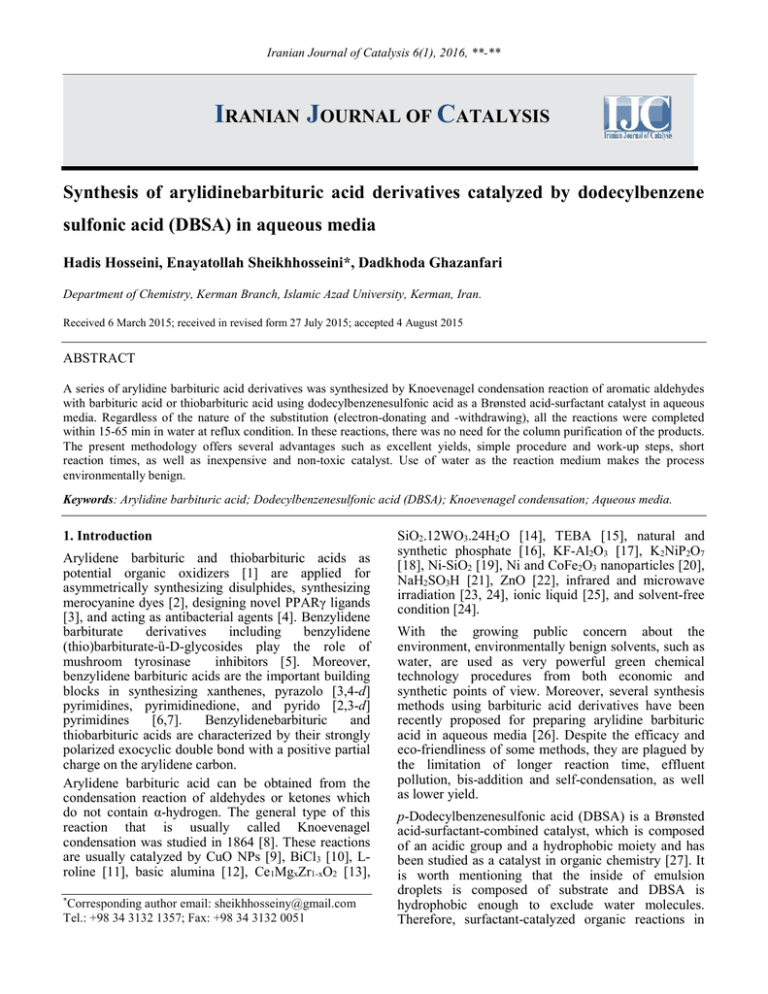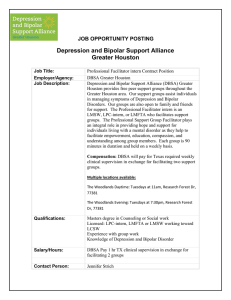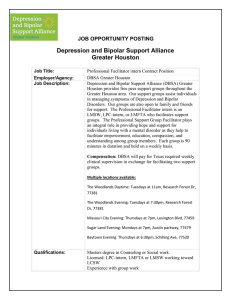IRANIAN JOURNAL OF CATALYSIS Synthesis of arylidinebarbituric
advertisement

Iranian Journal of Catalysis 6(1), 2016, **-** IRANIAN JOURNAL OF CATALYSIS Synthesis of arylidinebarbituric acid derivatives catalyzed by dodecylbenzene sulfonic acid (DBSA) in aqueous media Hadis Hosseini, Enayatollah Sheikhhosseini*, Dadkhoda Ghazanfari Department of Chemistry, Kerman Branch, Islamic Azad University, Kerman, Iran. Received 6 March 2015; received in revised form 27 July 2015; accepted 4 August 2015 ABSTRACT A series of arylidine barbituric acid derivatives was synthesized by Knoevenagel condensation reaction of aromatic aldehydes with barbituric acid or thiobarbituric acid using dodecylbenzenesulfonic acid as a Brønsted acid-surfactant catalyst in aqueous media. Regardless of the nature of the substitution (electron-donating and -withdrawing), all the reactions were completed within 15-65 min in water at reflux condition. In these reactions, there was no need for the column purification of the products. The present methodology offers several advantages such as excellent yields, simple procedure and work-up steps, short reaction times, as well as inexpensive and non-toxic catalyst. Use of water as the reaction medium makes the process environmentally benign. Keywords: Arylidine barbituric acid; Dodecylbenzenesulfonic acid (DBSA); Knoevenagel condensation; Aqueous media. 1. Introduction Arylidene barbituric and thiobarbituric acids as potential organic oxidizers [1] are applied for asymmetrically synthesizing disulphides, synthesizing merocyanine dyes [2], designing novel PPARγ ligands [3], and acting as antibacterial agents [4]. Benzylidene barbiturate derivatives including benzylidene (thio)barbiturate-ȕ-D-glycosides play the role of mushroom tyrosinase inhibitors [5]. Moreover, benzylidene barbituric acids are the important building blocks in synthesizing xanthenes, pyrazolo [3,4-d] pyrimidines, pyrimidinedione, and pyrido [2,3-d] pyrimidines [6,7]. Benzylidenebarbituric and thiobarbituric acids are characterized by their strongly polarized exocyclic double bond with a positive partial charge on the arylidene carbon. Arylidene barbituric acid can be obtained from the condensation reaction of aldehydes or ketones which do not contain α-hydrogen. The general type of this reaction that is usually called Knoevenagel condensation was studied in 1864 [8]. These reactions are usually catalyzed by CuO NPs [9], BiCl3 [10], Lroline [11], basic alumina [12], Ce1MgxZr1-xO2 [13], Corresponding author email: sheikhhosseiny@gmail.com Tel.: +98 34 3132 1357; Fax: +98 34 3132 0051 * SiO2.12WO3.24H2O [14], TEBA [15], natural and synthetic phosphate [16], KF-Al2O3 [17], K2NiP2O7 [18], Ni-SiO2 [19], Ni and CoFe2O3 nanoparticles [20], NaH2SO3H [21], ZnO [22], infrared and microwave irradiation [23, 24], ionic liquid [25], and solvent-free condition [24]. With the growing public concern about the environment, environmentally benign solvents, such as water, are used as very powerful green chemical technology procedures from both economic and synthetic points of view. Moreover, several synthesis methods using barbituric acid derivatives have been recently proposed for preparing arylidine barbituric acid in aqueous media [26]. Despite the efficacy and eco-friendliness of some methods, they are plagued by the limitation of longer reaction time, effluent pollution, bis-addition and self-condensation, as well as lower yield. p-Dodecylbenzenesulfonic acid (DBSA) is a Brønsted acid-surfactant-combined catalyst, which is composed of an acidic group and a hydrophobic moiety and has been studied as a catalyst in organic chemistry [27]. It is worth mentioning that the inside of emulsion droplets is composed of substrate and DBSA is hydrophobic enough to exclude water molecules. Therefore, surfactant-catalyzed organic reactions in H. Hosseini et al. / Iranian Journal of Catalysis 6(1), 2016, **-** water have turned to one of the most challenging research issues. The behavior of DBSA as a catalyst has been studied in Mannich type reactions, Biginelli reaction, synthesis of bis (indol-3-yl) alkanes, tetrahydrobenzo [b] pyrans, dihydropyrano [c] chromens, α,ά-bis (substituted benzylidene) cycloalkanones xanthenes derivatives, and esterification of various carboxylic acids and alcohols [28-33]. In the present work, these results were reported for the synthesis of arylidine barbituric acid derivatives by DBSA in environmentally benign conditions. 2. Experimental O S OH O 2.1. General IR spectra were recorded on a Perkin-Elmer FT-IR 240-C spectrophotometer (KBr). 1HNMR and 13CNMR spectra were run on Bruker spectrometers at 400 MHz for 1HNMR and 100 MHz for 13CNMR. Elemental analyses were carried out on a Heraeus CHN-O-Rapid analyzer. The melting points were determined using an Electrotermal 9100 and were then uncorrected. The reactions were monitored by thin layer chromatography and the products were identified either fully or in the comparison of melting points and spectroscopic data with the previously reported ones. 2.2. General procedure for the synthesis arylidine(thio)barbituric acid derivatives of A mixture of barbituric or thiobarbituric acid (2 mmol), substituted benzaldehydes (2 mmol), and DBSA (0.6 mmol) was stirred at reflux in 8 ml water. The progress of the reaction was monitored by TLC. After the reaction completion and upon its cooling, the solid material was precipitated from the solution. The precipitates were filtered off, washed with hot water, and re-crystalized from EtOH to obtain pure benzylidene barbituric acid derivatives as solids. Spectral data for unreported compound 5-(5-Bromo-2-hydroxybenzylidene)-dihydro-2thioxopyrimidine-4,6(1H,5H)-dione (3m): m.p.= 269-270°C. IR (KBr): ̅ = 3365, 3157, 1708, 1674, 1591 cm-1. 1HNMR (400 MHz, DMSO-d6): δ= 7.56 (d, J = 9.2 Hz, 1H, H-Ar), 7.98 (dd, J = 8.8, 2.4 Hz, 1H, H-Ar), 8.33 (d, J = 2.4 Hz, 1H, HAr), 8.98 (s, 1H, CH=), 9.62 (s, 1H, NH), 9.83 (s, 1H, NH), 11.38 (s, 1H, OH) ppm. 13CNMR (100 MHz, DMSOd6): δ= 116.9, 118.6, 118.7, 120.1, 132.5, 137.4, 148.4, 153.2, 159.9, 160.7, 180.3 ppm. Anal. calc. for C11H7BrN2O3S: C, 40.38; H, 2.16; N, 8.56; S, 9.80. Found: C, 39.29; H, 2.84; N, 10.35; S, 11.68. 3. Results and Discussion In this paper, a simple, efficient, convenient, and green method was described for the condensation of aldehydes with barbituric or thibarbituric acid, which led to the corresponding benzylidine barbituricacid derivatives in the presence of DBSA as a homogeneous (Scheme 1). DBSA was used as a source of H+ to catalyze this reaction and found as a good catalyst for the preparation of arylidene barbituric and thiobabituric acid derivatives. Initially, the systematic evaluation of different solvents for the model reaction of benzaldehyde (2 mmol) and barbituric acid (2 mmol) in the presence of DBSA in ethanol at reflux was focused on. Attempts which were made to study and optimize the reaction conditions showed that using the amounts of water in the media produced satisfactory results (Table 1, entry 4,5). These results revealed that the highest yield was obtained in water as the solvent (Table 1, entry 7). Since DBSA was emerged as a suitable catalyst for the reaction in H2O, efforts were made to examine the effects of the DBSA catalyst (5–30 mol%, 0.1-0.6 mmol) in the formation of benzylidine barbituric acid in water (Table 1). The present optimization studies revealed that the yield smoothly increased with the catalyst load up to 30 mol % (0.6 mmol); also the use of larger amounts of the catalyst did not improve the yields, while its decreased amount reduced the yields. The negligible amount of the product was formed in the absence of the catalyst. As shown in Table 2, aromatic aldehydes with both electron-withdrawing or donating substituents and barbituric or thiobarbituric acid produced benzylidene barbituric acid derivatives without the formation of any side products at high to excellent yields. As it can be seen in Table 2, a range of benzylidene barbituric acid derivatives was synthesized using (thio)barbituric acid and different aldehydes under the standardized reaction. Regardless of the nature of the substitution (electron-donating and -withdrawing) of the aromatic aldehydes, the products were obtained in excellent yields (Entries 1–13). Scheme 1. H. Hosseini et al. / Iranian Journal of Catalysis 6(1), 2016, **-** Table 1. Optimization of reaction condition for the yield of benzylidine barbituric acid.a Entry Solvent Temp. (°C) Time (min) Yield (%) DBSA (35%) EtOH Reflux 45 86 EtOH:H2O (1:1) Reflux H 2O r.t. 180 70 Reflux 15 35 1 DBSA (35%) 3 DBSA (35%) 2 4 EtOH 6 8 MeOH:H2O (1:1) DBSA (35%) H 2O Reflux H 2O Reflux DBSA (10%) 9 10 DBSA (20%) 12 DBSA (30%) 11 H 2O DBSA (25%) Isolated yield. 30 H 2O 85 15 85 15 38 15 Reflux H 2O 83 35 Reflux 45 15 Reflux trace 64 35 Reflux H 2O DBSA (15%) 120 Reflux DBSA (35%) DBSA (35%) 7 r.t. MeOH DBSA (35%) 5 a Catalyst 91 15 95 Table 2. Arylidenebarbituric acids derivatives obtained by the condensation of aromatic aldehydes with barbituric and thiobarbituric acid using DBSA as catalyst.a Entry R X Product Time (min) Yield (%) 1 C6H5- O 3a 15 95 3c 64 3e 61 2 3-NO2C6H4- O 3b 4 4-ClC6H4- O 3d O 3f 3 5 4-NO2C6H42-ClC6H4- O O 67 62 299-300 296-298 [28] 50 78 273-274 275-276 43 79 20 93 10 C6H5- S 3j 25 3i 64 48 13 5-Br-2-HOC6H3 S 3m 25 84 S 3l 15 Reaction conditions: DBSA (30 mol %, 0.6 mmol), Solvent: H2O and Reflux. a 297-299 [28] >320 >320 269-270 260 [10] 269-270 - This work 299 3k 4-HOC6H5- 296-298 82 S 80 [15] [28] 275-276 3-NO2C6H4- 272-274 252-254 91 11 12 280-286 254-255 20 O 61 93 3h 4-HOC6H5- [28] [28] O 9 262-264 238-241 4-(Me2N)C6H4- 3g 265 Ref 249-250 8 O Reported 71 2- MeOC6H44-MeOC6H4- Found 60 6 7 m.p. (°C) 300 (dec) [31] 276 [28] 250 [10] 360 [28] [10] H. Hosseini et al. / Iranian Journal of Catalysis 6(1), 2016, **-** All the reactions were completed within 15-65 min. In these reactions, there was no need for the column purification of the products. The obtained solid products were just filtered off from the reaction mixture, dissolved in hot ethanol, re-filtered to separate any contaminated catalyst with the product, and finally recrystallized from the filtrate to obtain pure products. The 1H NMR spectrum of the product 3m 5-(5-bromo2-hydroxybenzylidene)pyrimidine-2,4,6(1H,3H,5H)trione) showed a distinguished peak at region δ = 8.98 ppm for -CH olefin proton and tree singlet signals for changeable protons (δ = 9.62 and 9.83 for NH and 11.38 for OH). Partial assignments of these resonances for aromatic protons are given in the experimental section and expanded spectrum. The 13C NMR spectrum revealed two distinct peaks at δ = 160 and 161 ppm for the amide C=O groups and 180 ppm for C=S of the barbituric moiety. We estimated that the H-bond between hydroxyl group and NH moiety made this structure more unsymmetrical and so two NH protons and amide C=O groups were appeared. To show the advantage of the present work over the reported results in the literature, as represented in Table 3, DBSA can act as an effective catalyst in terms of reaction time and yields for the preparation of arylidene barbituric acid derivatives. 4. Conclusions DBSA as a Brønsted acid-surfactant-combined catalyst was demonstrated as a new efficient catalyst for the synthesis of arylidenebarbituric acid derivatives via the condensation reaction of aromatic aldehyde and barbituric acid under aqueous media. General applicability, mild reaction conditions and aqueous reaction media are notable advantages of the proposed procedure. Acknowledgment The authors thank Islamic Azad University (Kerman Branch) for supporting of this research work. References [1] M.L. Deb, P.J. Bhuyan, Tetrahedron Lett. 46 (2005) 6453-6456. [2] W. Frank, Y. Sheng, J. Org. Chem. 68 (2003) 89438949. [3] S. Sundrival, B. Viswanad, P. Ramarao, A.K. Chakraborti, P.V. Bharatam, Bioorg. Med. Chem. Lett. 18 (2008) 4959-4962. [4] T. Tihomir, Z. Nace, M.P. Manica, K. Danijel, P.M. Lucija, Eur. J. Med. Chem. 45 (2010) 1667-1672. [5] Y. Qin, C. Rihui, Y. Wei, C. Zhiyong, W. Huan, M. Lin, S. Huacan, Eur. J. Med. Chem. 44 (2009) 4235-4243. [6] H.S. Thokchom, A.D. Nongmeikapam, W.S. Laitonjam, Can. J. Chem. 83 (2005) 1056-1062. [7] J. Bo, C. Long-Ji, T. Shu-Jiang, Z. Wen-Rui, Y. HaiZhu, J. Comb. Chem. 11 (2009) 612-616. [8] G. Jones, Org. React. 15 (1976) 204. [9] N.R. Dighore, P.L. Anandgaonker, S.T. Gaikwad, A.S. Rajbhoj, Res. J. Chem. Sci. 4 (2014) 93-98. [10] K.M. Khan, M. Ali, T.A. Farooqui, M. Khan, M. Tahan, S. Perveen, J. Chem. Soc. Pak. 31 (2009) 823828. [11] S. Jain, N.R. Bhimireddy, S.R. Kolisetty, Int. J. Chem. Tech. Res. 3 (2011) 817-824. [12] A. Khalafi-nezhad, A. Hashemi, Iran. J. Chem. Chem. Eng. 20 (2001) 9-12. [13] S.B. Rathod, A.B. Ghamhire, B.R. Arbad, M.K. Lande, Bull. Korean. Chem. Soc. 31 (2010) 339-343. Table 3. Comparing of the present results with those reported in the literature for the preparation of arylidenebarbituric acid. Entry Reaction conditions Average yield (%) Time (min) 2 CuO nanoparticles/Solvent-free/ r.t. EtOH 45 4 TEBA/Water/ 70 °C 1 3 5 Microwave irradiation NH2SO3H/Grinding EtOH MeOH EtOH:H2O (1:1) L-pyroline/ethanol/60 °C MeOH:H2O (1:1) 7 Infrared irradiation/Solvent-free H 2O 9 DBSA (30 mol%)/H2O/Reflux H2O 6 8 CoFe2O4 nanoparticles /r.t. H2O/Reflux Ref. 120 [12,13] 30 [21] 35 [11] 15 [23] 35 H2O 180 H2O 15 15 [9] [15] [20] [26] This work H. Hosseini et al. / Iranian Journal of Catalysis 6(1), 2016, **-** [14] J.T. Li, M.X. Sun, Aust. J. Chem. 62 (2009) 353355. [15] D.Q. Shi, J. Chen, Q.Y. Zhung, X.S. Wang, H.W. Hu, Chin. Chem. Lett. 14 (2003) 1242-1245. [16] S. Sebti, A. Smahi, A. Solhy, Tetrahedron Lett. 43 (2002) 1813-1815. [17] G. Dai, D. Shi, L. Zhou, Y. Huaxue, J. Appl. Chem. 12 (1995) 104-108. [18] E.A. Maadi, C.L. Matthiesen, P. Ershadi, J. Baker, D.M. Herron, E.M. Holt, J. Chem. Cryst. 33 (2003) 757760. [19] V.S.R. Pullabhotla Rajasekhar, A. Rahman, S.B. Jonnalagadda, Catal. Commun. 10 (2009) 365369. [20] J.R. Kaur, G. Kaur, Chin. J. Catal. 34 (2013) 16971704. [21] J.T. Li, H.G. Dai, D. Liu, T.S. Li, Synth. Commun. 36 (2006) 789-794. [22] M.T. Maghsoodlou, N. Hazeri, S.M. HabibiKhorassani, Z. Shahkarami, N. Maleki, M. Rostamizadeh, M. Moradian, Iran. J. Org. Chem. 2 (2010), 391-395. [23] G. Alarreca, R. Sanabria, R. Miranda, G. Arroyo, J. Tamariz, F. Delgado, Synth. Commun. 30 (2000) 12951301. [24] C.S. Reddy, A. Nagaraj, Chin. Chem. Lett. 18 (2007) 1431-1435. [25] C. Wang, J. Ma, X. Zhou, X. Zang, Z. Wang, Y. Gao, P. Cui, Synth. Commun. 35 (2005) 2759-2764. [26] N. Zidar, D. Kikelj, Acta Chim. Slov. 58 (2011) 151157. [27] K. Manabe, Y. Mori, S. Kobayashi, Tetrahedron 57 (2001) 2537-2544. [28] M. Shiri, M.A. Zolfigol, Tetrahedron 65 (2009) 587-598. [29] M.A. Bigdeli, G. Gholami, E. Sheikhhosseini, Chin. Chem. Lett. 22 (2011) 903-906. [30] E. Sheikhhosseini, S.A. Ahmadi, S. Sadeghi, J. Appl. Chem. Res. 8 (2014) 25-30. [31] E. Sheikhhosseini, D. Ghazanfari, V. Nezamabadi, Iran. J. Catal. 3 (2013) 197-201. [32] Y.Y. Peng, Q.L. Zhang, J.J. Yuan, J.P. Cheng, Chin. J. Chem. 26 (2008) 2228-2232. [33] H. Hashemi, A.R. Sardarian, Iran. J. Sci. Technol. 1 (2013) 75-82.



